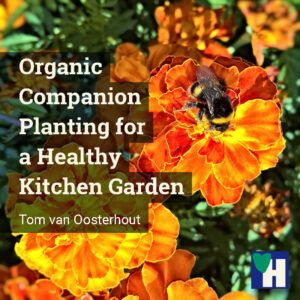
Organic companion planting is the key to a healthy kitchen garden. When toxic herbicides, pesticides, and fungicides aren’t allowed, as they aren’t in organic gardening, companion planting is the only solution.
From our following short introduction, you will get a limited grip on the ins and outs of companion planting. It requires knowledge of plants, plant diseases, insects that threaten and insects that benefit plants, which plants can be combined, and which not, etcetera. However, on a small scale as a kitchen garden, everybody will be able to manage the mutual dependencies.
Some of the links are affiliate links. As an affiliate associate, we earn a commission when you purchase any of the products offered through the shared links at no extra cost for you. This helps us maintain this website.
Table of contents
Ecological facilitation
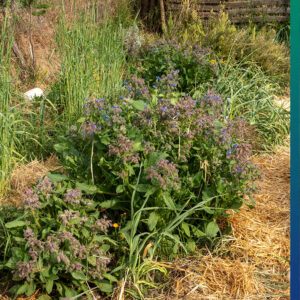
The classic belief about evolution is that competition procures the best results. Companion planting proves that life is more complicated. Some plants don’t mix well, but many others thrive when in proximity. The positive influence of one plant on the other is called ecological facilitation.
There are two types of ecological facilitation. The first is that both plants benefit from each other. The second is that one plant benefits and the other is not affected, not negatively and not positively. Epiphytes are a well-known example of the second type. Many orchids are epiphytes.
The benefits of ecological facilitation are substantial. Mutual support offers a refuge from physical stress, from predation (being eaten), and from the competition, and it offers improved resource availability and transport (which is important for reproduction).
The operation of organic companion planting
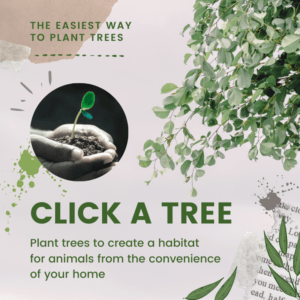
Some plants give off scents or chemicals that repel insects. Another type of plant prevents diseases or attracts insects, such as bees which are extremely important to pollination. And some plants break down the soil and help other plants to absorb vital nutrients.
Essentially companion planting is used to help plants to thrive without man-made chemicals. This is why companion planting is important for organic farming or organic, non-toxic gardening. It also illustrates how much more fun organic farming and gardening is, compared to the prevailing toxic chemical way.
Examples of organic companion planting
When you plant onions around your kitchen garden, it will keep out the rabbits. I guess they don’t like onions, just like Hannie. A friend of ours uses human hair in an old sock to keep out the jabalí (wild boars).
There are many other examples of the way in which plants help each other in organic companion planting. Here are just a few.
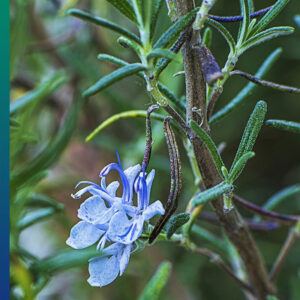
Basil and rosemary
Basil and rosemary are fine examples we use in our kitchen garden. It repels aphids, which are a common plague throughout most kitchen gardens. We also have a lot of rosemary in the garden. Rosemary repels carrot flies.
Marigolds
Marigolds are widely known to have a very strong fragrance. Many people consider it unpleasant despite the gorgeous flowers. However, many insects also find marigolds quite distasteful including nematodes (roundworms), whiteflies, beetles, and aphids.
To use marigolds as a companion plant, plant them at the perimeter of your garden. If your garden is large you may want to plant them throughout. Take care to not plant them too close to your vegetables because they do attract spider mites and slugs.
Alfalfa
Alfalfa actually helps the soil to absorb nitrogen, iron, magnesium, phosphorus, and potassium which makes the soil ideal for growing vegetables. Because alfalfa has very long and sturdy roots, it breaks up hard clay soil. It’s a great plant to help keep your soil rich in nutrients.
Geranium
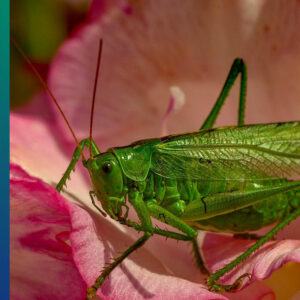
Geranium, another flower with a strong aroma, repels cabbage worms and Japanese beetles, and leafhoppers. Gardening experts recommend planting them around grapes, corn, tomatoes, peppers, and cabbage.
Leek
When you grow 2 rows of leek and onion next to each other, or 2 rows of leek and celery, the leek is protected from leek flies. Of course, you can combine leek, onions, and celery altogether. Leek also combines well with beans, salad, beetroot, tomatoes, and carrots. But not with radish or green peas.
What to plant and where
Before we began planting our organic garden, we did a bit of research to find the best spots for our chosen herbs and vegetables. For example, tomatoes do well with a number of other vegetables including garlic, chives, cucumber, and mint however not all vegetables get along with tomatoes. Tomatoes can stunt the growth of carrots and dill and kohlrabi slow tomato growth.
We made a map of our garden before planting and charted where we wanted to plant our herbs and vegetables. We took a course on organic gardening, visited an organic gardening site, and worked with a friend on his organic lands to learn more about the theory and practice of organic gardening and farming.
Companion planting is a very sustainable way to affect the health of our garden. Not only do we help our garden to stay pest and disease-free, but we also have the added benefit of a diverse and fruitful garden.
Visual control
No matter how ingenious we’ve composed our organic kitchen garden, the chance that it will totally remain pest and disease-free is limited. Our organic kitchen garden is not that big. We only have to check for unwanted animals once or twice a week. The bigger the garden gets, the more often a visual check is required.
Don’t hesitate to lift up the leaves and check underneath. Watch for changes in colors. Use a magnifying glass to identify small insects. The problem with identification is that there are millions and millions of insects.
A type of organization that might be helpful is the UK-based Amateur Entomologists’ Society. Their website is a fine introduction to the challenges facing the organic companion planting amateur.
Another helpful way to get to know more about the enemies of the organic kitchen gardener is to join a local or regional association of organic gardeners. We are members of the Murcia (Spain) based Red Murciana De Semillas (RMDS; Murcian Association of Seeds). A couple of years ago we participated in a course where we were introduced to how to grow organic companion planting.
Satoyama

There are many types of ecological farming. Such as fertility farming, organic farming, sustainable agriculture, agroecology, agroforestry, eco-agriculture, and permaculture.
In Japan, satoyama resembles permaculture. Satoyama is a mix of different types of small forests, connected with wet and dry rice fields, grasslands, and various water preserving and irrigation systems. This mix is an ideal environment to protect and enhance biodiversity.
Satoyama is sustained by traditional agricultural management practices. It’s no surprise that permaculture was inspired by the Japanese farmer and philosopher Masanobu Fukuoka’s idea of natural farming. To Fukuoka, farming is a means to cultivate and perfect human beings by mimicking nature.
Apparently, organic companion planting is not only important for a healthy garden but also for our personal health and the earth.
Do you know examples of organic companion planting? If you do, please write it down in the comment box.

Fascinating topic and one I certainly need more information on.
I will be in the planning stages of my garden for a while yet as it is still buried beneath some snow.
I did manage to get my hands into some dirt to start my tomatoes, peppers and hot peppers in preparation for transplant hopefully mid-May.
Because we are in a rural community I have a problem with deer, raccoons and rabbits munching away on my produce.
Not sure what to do about the deer and raccoons though, any ideas?
Do you add compost to your soil prior to planting?
What about yard leaves in the winter?
Hi Deb,
You’re quite right, it’s a fascinating topic, and it was great fun to write.
You have some challenging questions. Here in Spain people swear by a dog in the garden to keep all other animals out. Foxes, wild boars, and squirrels are the only ‘big’ animals we’ve seen here. We’ve had some hedgehogs in the garden. Blackbirds are the main threat to our garden, mainly when I’ve just put new seeds in the ground.
I assume, the dogs do a proper job, although it would be nice they trained them first to keep their mouths shut. We don’t have and don’t want a dog.
Where you live, I imagine it’s not possible to leave a dog outside during winter time. I also assume that a fence won’t keep raccoons and deer outside. As we’ve seen with friends of us who live on the south coast of Spain. They have a high wall around their garden. The wall does however not stop mountain goats to enter the garden.
A friend of ours uses human hair in an old sock and colored big plastic jerrycans (blue, yellow and red – not green), to keep the wild boar out of his fields. Wild boars smell the hair and think humans are around and the colored plastic jerrycans make them nervous because it’s something out of the ordinary. It works pretty well. No wild boars ever enter his lands.
Yes, I do add compost to the soil before planting. I also use a calendar which plants can be planted after each other on the same terrain and leave some of the terrain empty for half a year to recuperate. Now and then it’s also good to use manure to fertilize the soil. Farmers here use pig manure, but I prefer horse or goat manure. I never use much. Manure is nitrogenous, which is good, but too much burns your plants.
Now and then I also add some chalk to the soil. Because of the pine trees here, the soil is rather acidic. The chalk lowers the level of acidity. Not many plants like acidic soil. Except strawberries. They love it.
As you might understand from the pine trees, which produce a lot of needles, the use of yard leaves entirely depends on the type of leaves (or trees and plants). Some leaves are good, and enrich your soil, others poison your soil. Unfortunately, I don’t know which yard leaves are good and which aren’t. Except for the pine needles, which are not good.
I hope I was able to answer your questions.
For now, stay safe, stay healthy.
Regards,
Tom
Thanks for responding to my questions, Tom, I really appreciate it. Someone local suggested leaving a small portable radio on in the garden overnight to repel the deer.
We don’t have a dog and don’t want one. A couple of our children have dogs and they sometimes bring them to visit but then we are left to clean up the yard after they leave.
Thankfully this doesn’t happen often.
The leaves we have are from the great Canadian maple trees (we have 4 in the front yard) and the leaves break down beautifully over the winter. I add the leaves in the fall after I have harvested everything and till them in with the tractor.
I read that the maple leaves break down rather quickly and really improves the structure of the soil especially since we have a lot of heavy red clay here. Plus they are rich in nitrogen which is fabulous for the garden as you know.
I will be adding kitchen compost when I do the spring till but that won’t be until mid-May as it won’t be warm enough until then. We have a terribly short growing season which frustrates me to no end but it is what it is.
I grow as much as I can and can or freeze as much as I can so we are eating our veggies most of the year.
I did grow some leaf lettuce in a pot in the house this winter so we had some fresh lettuce throughout the winter.
Looking to learn about what else I can grow indoors for next winter.
Thanks again, Tom. Take care.
Hi Deb, have you seen this article? Grow your Own Herbs Indoors or Outside for Quality Herbal Tea. This might interest you as well. 🙂
Take care.
That is interesting, Tom!
I heard already about it but never got deep into the topic. Years ago, I tried to change our small garden into a vegetable garden, but I had so many problems with snails and caterpillars on my cabbage that I stopped again.
We tried tomatoes, but the summers here in the Netherlands are too wet. I believe you have the best weather for tomatoes and peppers.
Actually, I would love to try it again, maybe with seasonal vegetables that love rain and the cold over here. I need to use more compost to grow them stronger, but Mediterranean herbs don’t like compost so much. It is really a study to combine the right herbs and vegetables. Thank you very much, Tom! Great suggestions! I will do more investigation about companion planting. Maybe also try a course. 🙂
Hi Sylvia,
As far as I can remember, leek and onions are doing great in The Netherlands. And they love compost. The advantage of both leek and onions is that they keep a lot of insects away.
Snails are easy to catch with a deep plate filled with beer. Cheap beer does already wonders. No need to use tasty and expensive Belgian beers.
Caterpillars is more difficult. If possible, you have to keep the butterflies away of your field. Or you have to check the leaves of your plants every day for eggs.
The best way to keep insects away, is by regularly spraying your vegetables with a mix of garlic juice and soap. The mix must be prepared in such a way that the smell of the garlic is more pronounced than the smell of the soap. The best soap to use is natural, liquid and organic soap.
You can also use natural sulfur powder. It’s yellow, and you just powder the leaves of your plants with the stuff, just like you would powder a cake with powdered sugar. You must however be very careful with sulfur powder. You best use it when there is not much wind and little or no sun. Because sulfur is very aggressive, you have to cover your mouth with a mask to prevent the sulfur to enter your lungs.
What is perhaps even a better option is that you buy a wooden kitchen garden that you can turn into a green house. The advantage is that you have a much better control over the climate and the diseases and insects that might trouble your plants. Because you grow your plants at a higher altitude, it is also better for your back.
Although it’s not wise to use too much organic animal based fertilizer, when you mix your compost now and again with some cow, horse or goat manure, this will do your plants a lot of good. It’s better not to use pig manure. Not even the organic type. Pig manure has such an acid smell, that you will never get rid of it.
Nevertheless, you’re right. You should try a course. Maintaining a kitchen garden in The Netherlands, is quite different from one in Spain, I guess.
Thank you for your comment and compliments.
For now, stay safe, stay healthy.
Regards,
Tom
Hi Sylvia, Do you know the website of “Makkelijke Moestuin“? They are Dutch-based and have a huge number of tips you could use. And their (free) app is such a great help. I can really recommend it.
Amazing article, Hannie!
My aunt has an organic garden, and she’s doing companion planting. The taste and the quality of vegetables are amazing. I helped her a few times, and I can tell you that it’s a lot of work – but it’s worth it. If you don’t mind using translate (it’s in Croatian), here’s her website about it: http://organskocarstvo.blogspot.com/.
How do you handle pests? Do you have some organic mixtures or?
Hi Petar,
Amazing what you’re aunt does. Great job of hers. Of course, it’s a lot of work. But it’s very satisfying and relaxing. Besides, you’re right, the vegetables taste wonderful.
As I understand from your aunt’s website, she must know a lot about pests and how to handle them. I only know a few things. You can keep out snails with a plate of beer. Well, to be more exact, what happens is that the snails like beer and get into the plate. Because of the alcohol they drown.
A mix of garlic juice and soap will take care of certain insects that are harmful. I sometimes use sulfur powder on leaves to prevent mildew. Grasshoppers also don’t like sulfur powder. But there is much more.
Once we did a course on organic gardening. One of the teachers had a large box full of all kinds of organic stuff to control pests. He even had sticky pieces of paper that you have to hang on the plants in your field. The insects get on your plants and on the sticky pieces of paper. You have to check the pieces of paper regularly. When you find insects that are harmful to your plants, you have to remove all the insects manually from the plants or use organic pesticides.
For now, stay safe, stay healthy.
Regards,
Tom